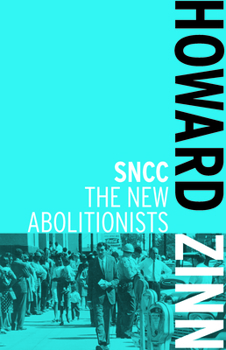SNCC: The New Abolitionists
Select Format
Select Condition 
Book Overview
Howard Zinn tells the story of one of the most important civil rights groups in American history.
Format:Paperback
Language:English
ISBN:1608462994
ISBN13:9781608462995
Release Date:December 2013
Publisher:Haymarket Books
Length:256 Pages
Weight:0.20 lbs.
Dimensions:0.9" x 5.3" x 8.1"
Customer Reviews
2 ratings
Anatomy of a Revolution
Published by Thriftbooks.com User , 20 years ago
Following the out break of sit-ins accross the upper south, originated by and participated in largely by Black college students, the students founded the Student Non-Violent Coordinating Committee, in an attempt to bring some order to these spontaneous direct actions.In 1960, a group of thes students decided to bring democracy to Mississippi and other deep south states. Zinn was with them, and (being a historian, after all) wrote down what he saw. As Zinn admits, this is not a history. It is closer akin to contemporaneous journalism.What Zinn does is dramatize just how far from democracy and the rule of law Mississippi was in the early 60's (at least for Black people--but it is hard to believe that this form of autocratic government didn't spill over into the "White" government as well.The Federal Constitution did not apply. State law did not apply. A student standing on the steps of the federal building (of all places) is arrested, beaten to unconsciousness, and sent to hard labor at the notorious Parchman Farm. All for simply watching a line of black citizens attempt to register to vote. All this while the FBI stands by, and does nothing but take notes.Looking back from the perspective of 40 years on, we tend to glamorize the civil rights movement--the Supreme Court decided Brown, Rosa Parks refused to sit in the back of the bus, King gave a speech about his dream, and then Congress solved the problem by passing the Civil Rights Law.What Zinn makes clear is that while all of this was happening on the national level, the real battle was taking place person by person in the deep south. The heroes were not limited to Dr. King and Rosa Parks, but included hundreds of yuoung people (the members of SNCC) who turned their backs on middle class educations, and literally put their bodies on the line (and all too often in the hospital) to force the power tructure in the South to recognize the rule of law.The courage and creativity of these young men and women comes through dramatically in Zinn's account--it is inspiring, and terrifying at the same time. Terrifying just how close to tyranny this country was in the early 60's. Inspiring to know that young people had the courage, intelligence, determination, and focus needed to battle that tyranny under the most oppressive conditions this country has known since the civil war. Remember, the horror of Emmit Till was only a few years in the past when these men and women decided to openly challenge the existing power structure.And best of all, they won. Read the book.
A very informative history of SNCC's early years
Published by Thriftbooks.com User , 22 years ago
The Officers and Members Student Non-Violent Coordinating Committee (SNCC) were the foot soldiers of the Civil Rights Movement. They went into the dangerous areas of the South and attempted to register voters and challenge local segregation ordinances. Howard Zinn documents this in this social history of SNCC. He also gives information on Fannie Lou Hamer, John Lewis and other prominent SNCC leaders.





